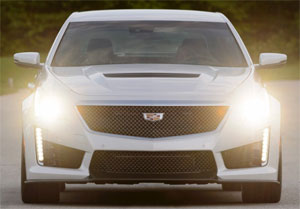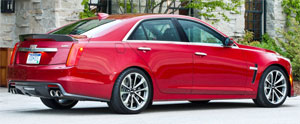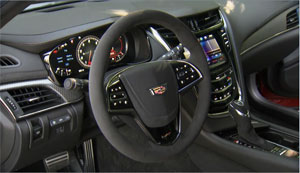2016 Cadillac CTS-V
No matter where your car company hails from, if you build a sport sedan, you’ll ultimately get compared to the companies that have done it the best, for the longest time: The Germans! BMW, Mercedes, and VW/Audi. Whether that’s fair or not, is a topic for another day. Because right now, we’ve got a home grown contender to put through its paces, the Cadillac CTS-V!
American carmakers have been trying to catch up, and one-up the German sport sedan concept for over half a century. Numerous times critics, including us, thought they got close. But, it took the 21st century Cadillac brand to really close the gap, with the 2016 CTS-V aiming to fill it for good.
The CTS-V is the original V “for Velocity” of course, but just about everything that makes it go fast now, comes from the Chevrolet Corvette; making this essentially a four-door Corvette with a nicer interior.
That kinship start naturally enough under the hood with the Z06’s glorious 6.2-liter chunk of supercharged aluminum with pushrods, producing 640-horsepower and 630 lb-ft. of torque. The M5 and E63 AMG don’t even come close.
This thing is clearly not some mild-mannered pretender. Just hearing it rumble at startup will put fear into you; floor it and its “oh my gosh” awesome power!
 It is still built on the ATS platform, but significant structural bracing had to take place; and like some of us around here, has stiffer joints all around. Oh yeah, it’s race car rigid.
It is still built on the ATS platform, but significant structural bracing had to take place; and like some of us around here, has stiffer joints all around. Oh yeah, it’s race car rigid.
Just as in some front-wheel-drive transaxles that feature unequal half-shafts to prevent torque steer; a similar arrangement in the CTS-V’s rear, works to quell axle hopping on hard acceleration. The results are, according to the factory, a blistering 3.7-seconds to 60.
There are Brembo brakes obviously; and topping it off, GM stuffed as much rubber into the wheel wells as possible; 265/35/19 Michelin Pilot Super Sports in front, 295/30/19s in back.
We’ve said it many times before about V-Series cars; you really need to get them on a race track for full affect. Tooling to the winery on the weekend or even slicing up your local back roads in this CTS-V does not reveal the true story of how competent it is.
So we jumped at the change to try it out a Road America! Yep, this Caddy is one awesome track machine. Between Performance Traction Management and the power distributing electronic limited-slip differential, you have no trouble getting all 640 horses to the pavement with little concern about being out of control.
 More power than the Germans, and better use of it than hotrods like Hellcats and Shelby’s. And that very linear power delivery also works well with the 8-speed automatic transmission that comes with all CTS-Vs.
More power than the Germans, and better use of it than hotrods like Hellcats and Shelby’s. And that very linear power delivery also works well with the 8-speed automatic transmission that comes with all CTS-Vs.
There’s plenty of mid-range muscle coming out of turns; with minimal weight transfer thanks to Magnetic Ride Control, even with a hefty 4,145-lbs. to manage. Brakes are all day long durable.
Driven hard it seems to move around on you a little, but it seems to catch itself and never get out of shape. You know there’s electronic intervention happening, but you still feel in total control.
There’s a more aggressive look to go along with all of that performance. Virtually every body panel is unique and purposefully designed to maximize downforce, minimize lift, or enhance cooling.
The air-extracting hood is made of carbon fiber as are the front splitter, rear diffuser, and spoiler if you opt for the carbon fiber package.
 As for the interior, thankfully it does not appear like it was done on a shoestring budget; just an enhanced performance feel thanks to sueded materials, performance seats, Head Up display, and of course the Corvettes’ Performance Data Recorder.
As for the interior, thankfully it does not appear like it was done on a shoestring budget; just an enhanced performance feel thanks to sueded materials, performance seats, Head Up display, and of course the Corvettes’ Performance Data Recorder.
And perhaps most important of all, it doesn’t feel any less Cadillac when you’re driving sanely.
Government Fuel Economy Ratings are 14-City, 21-Highway, and 17-Combined. So there is a gas guzzler tax.
Base price is $85,990. And if that’s too much, don’t forget that this big V has a little brother ATS-V which packs almost as much performance for $61,460.
Now, we know that many sport sedan aficionados will never be convinced that a four-door designed anywhere but Germany is worth a second look. But, if you have an open mind, then you’ll see where we’re coming from when we say that hands down, the 2016 Cadillac CTS-V beats all comers in the traditional European sport sedan category in every way! And we’re just ecstatic to be along for the ride.
Specifications
- Engine: 6.2 liter
- Horsepower: 640
- Torque: 630 lb-ft.
- 0-60 mph: 3.7 seconds
- EPA: 14 mpg city / 21 mpg highway
2024 Polestar 2
More Range And More Power For The Polestar 2
Volvo is well on their way to making the transition to an all-electric brand, but their sister-brand Polestar is already there. Now, we’ve spent lots of time in their all-wheel drive, five-door Polestar 2, having tested it in 2021, and a year later when a two-wheel drive version arrived. But, EV updates are coming quickly. So, let us be your guide for all that’s new with the Polestar 2.
While we are driving more EVs than ever, we’ve also been spending a lot of time recently circling back to ones we’ve previously tested. As in this new era of electrified vehicles, significant updates are arriving quickly, with R&D investments increasing and retrofitting them easier than ever. This is often done through software updates that can even be accomplished over the air. For 2024, the Polestar 2 has indeed gotten some software updates, but some physical ones as well.
Clearly aimed directly at Tesla’s Model 3 when it arrived; the Polestar 2’s build quality was vastly better, but range definitely came up short. So, addressing that was priority No. 1; and for ’24 the Polestar can travel up to 20% farther than before while consuming 9% less energy, and when it comes time to charge it back up, it can do that 34% faster too.
Range in the Single Motor version increases from a max of 270 to 320 miles thanks to a larger 82-kWh battery pack, and that solitary motor now powers the rear wheels, not the front wheels. It’s also bigger, coming in at 220 kW compared to the previous 170 kW front-wheel drive version, going from 231 to 299 horsepower.
Dual Motors keep the same 78-kWh battery, but still sees a boost from 260 to 276 miles and takes advantage of the larger rear motor for a new combined 310-kW output with 421 horsepower. Our test car has the added Performance Pack, which uses an additional 35 kW to deliver 455 horsepower and 546 lb-ft of torque, though max range drops to just 247 miles.
The new battery in rear-drive 2s will also charge faster, now accepting up to 205 kW for an 80% charge in 20 minutes; max for dual-motors stays at 155 kW, which puts an 80% charge at 34 minutes. Using 32 kWh of electricity per 100 miles, the Dual Motor earns a good efficiency rating.
The [Polestar] 2 has always been one of the most enjoyable EVs to drive, even more so now with that additional power coming from the rear motor.
Unfortunately, extremely cold temperatures kept us from seeing that increased range, as we were only on pace for about 194 miles in our test.
The 2 has always been one of the most enjoyable EVs to drive, even more so now with that additional power coming from the rear motor. And especially when equipped with the Performance Pack as it not only includes more power, but adds 20-inch forged wheels, upgraded brakes, and adjustable Ohlins Dual Flow Valve performance dampers. It greatly improves handling prowess without affecting ride quality, and is easily worth the $5,500 charge if you at all enjoy driving.
Even on a 20-degree track day there was plenty of grip through our handling course. No understeer or oversteer, and lots of feedback through the wheel. There was a nice, strong launch off the line that properly planted us firmly in the seat, and rocketed us to 60 in 4.5 seconds. Power delivery stayed pretty intense up until about 80 mph when there was a definite tapering off. Still, it was a 13.4-second quarter-mile at 102 mph; smooth, quiet, and stable the whole way.
When this car debuted, its Google-based infotainment setup was a novelty, but since then, more and more manufacturers are just “Googling it” so it doesn’t seem out of place at all. The wireless phone charger is easy to access, and there’s a great Harmon/Kardon sound system and panoramic sunroof to enhance the in-cabin experience. Exteriors have also been enhanced with a smooth grille insert and new wheel choices.
Hatchback practicality means 14.3 cu-ft of easy to access cargo space with split-folding seatbacks for longer items and expanding the space to 38.7 cu-ft. Plus, there’s even a sizeable storage bin up front under the hood.
Single Motor Polestar 2 pricing now starts at $51,300, with Dual Motors starting at $56,700; topping out at $64,400.
For a car manufacturer that hasn’t even been around for a decade yet, Polestar has kept itself busy, totally transforming their latest model in just a few years, making the 2024 Polestar 2 even more appealing. They are certainly off to a good start, and with a host of Polestars just over the horizon, including some all-important utility vehicles, this star will be shining even brighter.
Specifications
As Tested
- Motor Setup: Dual Motor
- Horsepower: 455
- 0-60 mph: 4.5 seconds
- EPA Range: 247 miles
- Efficiency : 32 kWh / 100 miles
- Battery Size: 78-kWh
- Torque: 546 lb-ft
- 1/4 Mile: 13.4 seconds at 102 mph
- MW Test Loop: ~ 194 miles
- Peak Charging Rate: 155 kW











































